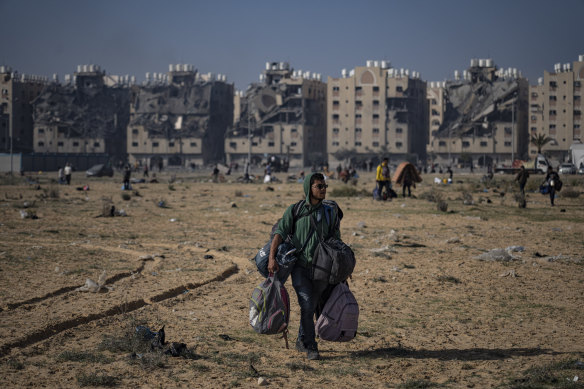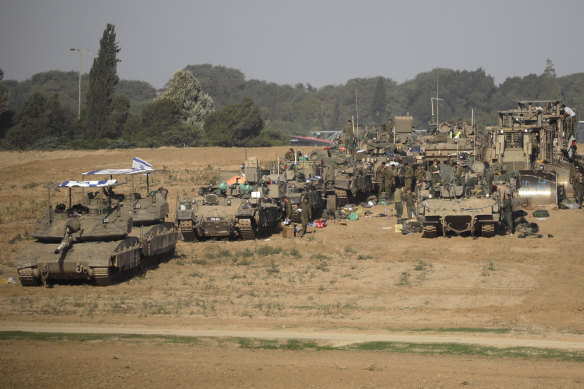This was published 1 year ago
Israel says it will hit crowded south Gaza as hard as it hit north
By Najib Jobain and Kareem Chehayeb
Khan Younis: Israel’s ground offensive expanded to every part of the Gaza Strip, its military said Sunday, as it ordered more evacuations and vowed to hit south Gaza with “no less strength” than the fight that has reduced large parts of north Gaza to a moonscape.
Heavy bombardment followed the evacuation orders, and Palestinians in the sealed-off territory bordering Israel and Egypt said they were running out of places to go.
Many of its 2.3 million people are crammed into the south after Israel ordered civilians to leave the north in the early days of the war, which was sparked by the October 7 attack by Hamas and other militants that killed about 1200 people, mostly civilians, in southern Israel.

Palestinians flee from east to west of Khan Younis during Israeli bombardments.Credit: AP
The United Nations estimates that 1.8 million Gazans have been displaced. Juliette Toma, the director of communications at the UN agency for Palestinian refugees, said nearly 958,000 of them were in 99 UN facilities in the south.
After dark, gunfire and shelling were heard in the central town of Deir al-Balah as flares lit the sky. Israeli drones buzzed overhead in Gaza’s second-largest city, Khan Younis. UN human rights chief Volker Türk urged an end to the war, saying civilian suffering was “too much to bear.”
Residents said the military dropped leaflets calling Khan Younis “a dangerous combat zone” and ordering them to move to the border city of Rafah or a coastal area in the south-west.
Halima Abdel-Rahman, a widow and mother of four, said she wouldn’t heed such orders any more. She fled her home in October to an area outside Khan Younis, where she stays with relatives.
“The occupation tells you to go to this area, then they bomb it,” she said by phone. “The reality is that no place is safe in Gaza. They kill people in the north. They kill people in the south.”
The Health Ministry in Hamas-run Gaza said the death toll there since October 7 has surpassed 15,500. The ministry does not differentiate between civilian and combatant deaths, but said 70 per cent of the dead were women and children. It said more than 41,000 people had been wounded.
A Health Ministry spokesman asserted that hundreds of people had been killed or wounded since the ceasefire ended on Friday. “The majority of victims are still under the rubble,” Ashraf al-Qidra said.
Meanwhile, fears of a wider conflict intensified. A US warship and multiple commercial ships came under attack in the Red Sea, the Pentagon said. Yemen’s Iran-backed Houthi rebels claimed attacks on two ships they described as being linked to Israel but did not acknowledge targeting a US Navy vessel.
The United States, Israel’s closest ally, has urged Israel to avoid significant new mass displacement and do more to protect civilians. US Vice President Kamala Harris also told Egypt’s president that “under no circumstances” would the US permit the forced relocation of Palestinians from Gaza or the West Bank, an ongoing siege of Gaza or the redrawing of its borders.

Israeli tanks and armoured vehicles near the southern Gaza Strip border.Credit: Getty
On the ground in Gaza, there was frustration and mourning. Outside a Gaza City hospital, a dust-covered boy named Saaed Khalid Shehta dropped to his knees beside the bloodied body of his little brother Mohammad, one of several bodies laid out after people said their street was hit by airstrikes. He kissed him.
“You bury me with him!” the boy cried. A health worker at Al-Ahli Baptist Hospital said more than 15 children were killed.
Israel’s military said its fighter jets and helicopters struck targets in the Gaza Strip including “tunnel shafts, command centres and weapons storage facilities,” while a drone killed five Hamas fighters. Military officials acknowledged “extensive aerial attacks in the Khan Younis area”.
Mark Regev, a senior adviser to Prime Minister Benjamin Netanyahu, said Israel was making “maximum effort” to protect civilians. In addition to the leaflets, the military has used phone calls and radio and TV broadcasts to urge Gazans to move from specific areas.
Israel says it targets Hamas operatives and blames civilian casualties on the militants, accusing them of operating in residential neighbourhoods. It claims to have killed thousands of militants, without providing evidence. Israel says at least 78 of its soldiers have been killed in the offensive in northern Gaza.
The renewed hostilities have heightened concerns for the 137 hostages who the Israeli military believes are still being held by Hamas. During the recent truce, 105 hostages were freed, and Israel released 240 Palestinian prisoners. Most of those released by both sides were women and children.
Israeli forces have found 800 shafts leading to Hamas’ vast subterranean network of tunnels and bunkers since a Gaza ground operation began on October 27, and have destroyed more than half of them, the military said.
The Palestinian Islamist group said before the now eight-week-old war in the Gaza Strip that it had hundreds of kilometres of tunnels - a network comparable in size to the New York subway system - to protect and serve as operational bases.
Elsewhere in the region, Lebanon’s militant Hezbollah group said it struck Israeli positions near the tense Lebanon-Israel border. Eleven people – eight soldiers and three civilians – were wounded by Hezbollah fire in the area of Beit Hillel, army radio reported. The military said its artillery struck sources of fire from Lebanon. It also said its fighter jets struck other Hezbollah targets.
And Iraqi militants with the Iran-backed umbrella group the Islamic Resistance in Iraq said they struck the Kharab al-Jir US military base in Syria with rockets. A US military official, speaking on condition of anonymity in line with regulations, said rockets hit Rumalyn Landing Zone in Syria but there were no reports of casualties or damage.
AP, Reuters